Rudolph von Ripper
Rudolph Carl von Ripper (January 29, 1905 – July 9, 1960) (sometimes Rudolph Charles von Ripper or Rudolph Ripper[note 1]), known as 'Rip' or 'Jack the Ripper', was an Austrian-born American surrealist painter and illustrator, soldier and Office of Strategic Services agent.
Rudolph Carl von Ripper | |
|---|---|
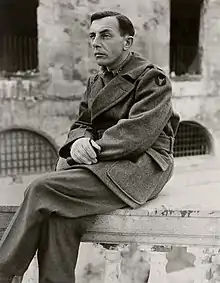 In 1943, wearing the red bull shoulder badge of the US 34th Infantry Division | |
| Born | 29 January 1905 |
| Died | 9 July 1960 (aged 55) |
| Citizenship |
|
| Occupation | Artist, soldier, OSS agent |
| Spouse(s) | Dorothea "Mopsa" Sternheim
(m. 1929; div. 1947)Evelyn Leege (m. 1947) |
| Military career | |
| Allegiance |
|
| Service/ |
|
| Rank | Captain |
| Battles/wars | |
| Awards |
|
Life
Early life
Rudolph von Ripper was born in 1905 in Cluj, at the time in Austria-Hungary and now in Romania. He was the son of an Austrian baron and general who was the last aide de camp to Charles I of Austria.[1][2] After his father's death and the collapse of the Austro-Hungarian empire, he ran away from home and worked in various jobs including as a coal miner and a circus clown,[3] before studying art at the Kunstakademie Düsseldorf.[4]
Paris and the French Foreign Legion
He then moved to Paris, where in 1925, aged 19, he joined the French Foreign Legion. He served in the Legion for two years, being deployed against the Great Syrian Revolt, where he was wounded in action.[4][3]
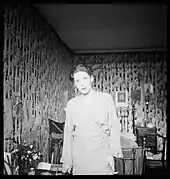
Berlin, Shanghai and Mallorca
He then deserted the legion, and moved to Berlin, before traveling to Shanghai in 1928 as a filmmaker.[3][4]
On his return to Berlin in 1928, von Ripper began a relationship with stage designer Dorothea "Mopsa" Sternheim. Sternheim was also in love with surrealist writer René Crevel, who also had feelings for von Ripper,[5] and for a time there was a plan for a ménage à trois; however, this did not come about, and Sternheim and von Ripper married on 17 December 1929.[6]
The couple settled in Berlin, where they were part of the decadent Weimar culture of the city in the early 1930s.[4] However, at some point during the 1930s the couple separated and Sternheim began seeing other men and women.[6]
Around 1933, von Ripper traveled to Mallorca, where he produced anti-fascist drawings to the commission of the German resistance.[7]

Concentration camp
In October 1933, von Ripper returned via Paris to Berlin, now under Nazi rule, bringing with him copies of the 'Braunbuch',[7] an anti-Nazi publication written by German left-wing groups in exile and published in Paris.[8] He was taken to the office of Gestapo chief Rudolf Diels, and accused of high treason for his production of anti-Nazi cartoons and possession of anti-Nazi pamphlets.[4]
He was imprisoned and tortured for some months in Oranienburg concentration camp,[1] until in 1934 he managed to get a message to Austrian Chancellor Engelbert Dollfuss, who intervened to have him released, with a requirement to leave all Nazi-held territories.[7][4][2][3]
Return to Mallorca and Spanish Civil War
He returned, via Amsterdam and Paris, to Mallorca, where he created a series of pieces entitled Ecrasez l'infame (To Crush Tyranny), a reference to Voltaire.[7] These were published in Paris in a limited edition in 1938.[9]
In October 1935, fourteen of his pieces under the title "Kaleidoscope" were exhibited at the Tooth Gallery in London,[10][11] and according to the New York Times "created a sensation in the art world".[1] The German ambassador asked that the show be censored, but British authorities refused.[4]
After the outbreak of the Spanish Civil War in 1936, in which General Francisco Franco's coup was supported by troops from Nazi Germany, von Ripper joined the Republican Army, with the specific aim of fighting the Germans.[4] In 1937, he was serving as an aerial gunner in the Spanish Republican Air Force when his plane was shot down and his left leg riddled with metal from a shell.[1] He was told by doctors that his leg would have to be amputated, but left before they could do so.[4]
Move to the United States, Time and Fortune magazines
In 1938, his health too damaged to fight further, he traveled to New York City,[7][3] where he settled for a while in Greenwich Village and he held exhibitions at the A.C.A and Bignou galleries.[11]
He then earned a residency at the Yaddo artists' community,[12] before moving to New Canaan, Connecticut where he established an art studio in a century-old barn.[11][1][4]
In January 1939, Time used von Ripper's picture captioned 'From the unholy organist, a hymn of hate', from Ecrasez l'infame, on the front cover of the issue which named Adolf Hitler as 1938's Man of the Year.[13][14]
TIME'S cover, showing Organist Adolf Hitler playing his hymn of hate in a desecrated cathedral while victims dangle on a St. Catherine's wheel and the Nazi hierarchy looks on, was drawn by Baron Rudolph Charles von Ripper, a Catholic who found Germany intolerable.
— Time magazine, Jan 2 1939[13]
The issue also contained a profile of von Ripper and his art, under the heading 'Art: Enemy of the State'.[15] Another picture by von Ripper, depicting Nikolaus von Falkenhorst, was used on the cover of Time magazine on May 13, 1930.[16]
In 1939, he produced illustrations for Norman Corwin's book Seems Radio is Here to Stay.[17]
During this period his art also began to appear in Fortune magazine.[18]
In 1941, Rudolph and Mopsa were officially expelled from the German Empire.[19]
US Army and OSS service

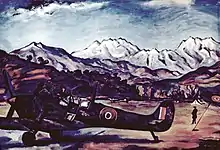
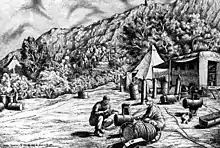
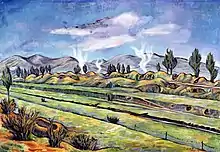
When the United States joined World War II, in 1941, von Ripper attempted to join the army as a soldier, but was initially rejected due to his health.[4] Meanwhile, he painted propaganda posters intended for distribution abroad for the Office of War Information.[20]
Eventually, on September 5, 1942, he was admitted to the United States Army[2] for 'limited service only' due to his wounds,[4] and initially served as a hospital laboratory technician.[1] On the formation of the Corps of Engineers War Art Unit, he transferred to that unit and in 1943 sent to North Africa as an Artist Correspondent alongside Mitchell Siporin.[2][4]
In 1943, he became a United States citizen.[1]
He worked alongside Pulitzer Prize-winning journalist Ernie Pyle, who in his 1944 book Brave Men wrote:
One of the most fabulous characters in that war theater was Lieutenant Rudolf Charles von Ripper. He was so fabulous, a man might have been justified in thinking him a phony until he got to know him. ... He was no phony. Von Ripper was the kind they write books about.
— Brave Men, by Ernie Pyle, 1944[3]
The Army Artist Unit was dissolved in May 1943, and von Ripper transferred to the Intelligence Section to interrogate prisoners. He was assigned to the 34th Infantry Division, with whom he took part in the Invasion of Italy.[4][1]
In Italy, he served as acting intelligence officer of the 2nd Battalion of the 168th Infantry Regiment.[21] He also led patrols against Nazi positions, either with squads of soldiers or alone.[1] For actions in these sorties he was awarded a Silver Star and oak leaf cluster, and on December 12, 1943 was promoted to second lieutenant,[4] which fellow artist Sergeant Mitchell Siporin described as 'a battlefield appointment about which much should be said'.[2] He also received a Purple Heart with oak leaf cluster and a Division Citation.[2]
Von Ripper and one of his men advanced in the face of intense enemy fire and killed two and wounded three of the enemy, took 11 prisoners and captured numerous enemy weapons
— Citation for Oak leaf cluster to a Silver Star, quoted in Von Ripper: Painter with a Gun by Peter Carlson[4]
In a later sortie, he was ambushed and wounded in his right hand, left leg and face by machine gun bullets. He was taken to Naples to recover, where he continued to work on paintings based on his front line sketches.[4] He became sufficiently known for his audacity when leading patrols that his division forbade him going on patrol without specific permission.[3]
In December 1943, his art was included in The Army at War, a War Department exhibition of combat art. Writing in the catalog for the exhibition, von Ripper wrote:
A soldier-artist is a painter with a gun, a man to fight at times and to paint at other times. And in that he is very lucky: He can divert his effort from destruction, from killing, which is the soldier’s job, to creative work, to build, make new things.
— Rudolph von Ripper, quoted in The Army at War, War Finance Department 1943[2]
In February 1944 he returned to the front lines and was involved in the Battle of Monte Cassino.[4]
His exploits drew the attention of Office of Strategic Services (OSS) director William J. Donovan, and he was recruited for its Secret Intelligence Branch.[1] He parachuted into Austria early in 1945 to organize resistance and inform the OSS about the situation.[4] After the war ended, von Ripper was involved in finding Gestapo and Nazi officials hiding in Austria.[4][1]
After the war
He left the OSS in late 1945 with the rank of Captain,[20][4] though some commentators suggest he continued as an operative for the Central Intelligence Agency.[7] His final official evaluation form assessed him as "Outstanding in fieldwork but too restless for staff work".[4]
He returned to Europe in 1946 and taught at the Academy of Fine Arts Vienna.[22]
Around this time he obtained a divorce from Mopsa, and married art critic Evelyn Leege, with whom he returned to his pre-war home in Connecticut.[4] He earned two Guggenheim Fellowships for fine art painting, in 1945 and 1947.[23]
In 1947, a portfolio of thirty of von Ripper's etchings was published in New York in 200 numbered editions, under the title "With the 34th Infantry Division in Italy" with a foreword from Major General Charles W. Ryder.[24][25]
In 1950, Rudolph and Evelyn moved to a villa called Ca'n Cueg near Pollença on Mallorca, despite the island still being under the Francoist regime that von Ripper had fought against in the 1930s.[7]
In 1960, returning from a four-month trip, von Ripper was arrested by Spanish police and charged with smuggling. His wartime comrade C. L. Sulzberger, who had cautioned him against returning to Mallorca, believed that this might be the Spanish regime seeking revenge against him.[4]
Death
On July 9, 1960, while on bail awaiting trial, von Ripper stepped outside the villa. He was found dead the following morning by Evelyn, with his death recorded as being from a heart attack,[4] though some commentators including biographer Sian Mackay have considered the death suspicious.[7]
His obituary in the New York Times was headed, "Rudolf von Ripper, Artist, Dies; War Hero Served With O. S. S.".[1]
In the 1990s, workers clearing out the Ca'n Cueg villa found a large number of papers and sketches belonging to von Ripper, which formed the basis of Sian Mackay's book Von Ripper’s Odyssey: War, Resistance, Art and Love.[7]
Literature
- Klaus Mann: Écrasez l’infâme (1936), republished in Das Wunder von Madrid. Rowohlt Verlag, Reinbek b. Hamburg 1993, pp. 232–236.
- C. L. Sulzberger: Unconquered Souls. The Resistentialists. Woodstock, Overlook Press, 1973
- S. Koja, C. Tinzl: Rudolf Charles von Ripper – Werk und Widerstand. Ausstellungskat. Linz, Salzburg 1989
- Dietmar Horst: Der Tänzer auf den Wellen – Das merkwürdige Leben des Rudolf Charles von Ripper. Berenkamp Verlag, Hall/Wien, 2010
- Dietmar Horst: Der letzte große Romantiker. In: Salzburger Nachrichten, 2010, S. VII (Beilage)
- Jörg Deuter, Gert Schiff: Von Füssli zu Picasso. Biographie einer Kunsthistoriker-Generation. Weimar, 2013. pp. 160–165.
- Sian Mackay: Von Ripper’s Odyssey: War, Resistance, Art and Love. Thistle Publishing, London. 2016
Notes
- After the abolition of the Austrian nobility in 1919, Austrian nobles were no longer entitled to use 'von' in their names. However, they were still able to use the honorific abroad and von Ripper continued to do so.
References
- "Rudolf von Ripper, Artist Dies: War Hero Served With O.S.S." New York Times. 14 July 1960.
- The Army at War: A Graphic Record by American Artists. United States. War Finance Division. 31 December 1943.
- Pyle, Ernie (1944). Brave Men. Henry Holt & Co. pp. 147–50. ISBN 0803287682.
- Carlson, Peter (May 2014). "Von Ripper: Painter with a Gun". Military History. HistoryNet.
- Crevel, René; Sternheim, Mopsa (1997). Lettres a Mopsa. Paris-Méditerranée. ISBN 9782842720094.
- Martynkewicz, Wolfgang (2017). Tanz auf dem Pulverfass: Gottfried Benn, die Frauen und die Macht. Aufbau Digital. ISBN 9783841212979.
- Mackay, Sian (January 2018). "Guns and art: Rudolph von Ripper's fight against tyranny" (PDF). Jewish Renaissance. Renaissance Publishing.
- Palmier, Jean-Michel (2006). Weimar in Exile: The Antifascist Emigration in Europe and America. Verso. pp. 315–320. ISBN 9781844670680.
- "Rudolf von Ripper Portfolio [Ecraser L'Infame]". Live Auctioneers. September 26, 2019.
- "Kaleidoscope" : fourteen surréaliste drawings by Rudolph von Ripper : October 2nd-October 19th 1935. Arthur Tooth & Sons. 1935. OCLC 1011795616.
- Lansden, Ollie P (11 April 1943). "Cpl Rudolph Von Ripper Completes Mural For Library At William Beaumont Hospital". El Paso Times.
- Mangione, Jerre (2001). An Ethnic at Large: A Memoir of America in the Thirties and Forties. Syracuse University Press. ISBN 9780815607168.
- "Adolf Hitler: Man of the Year, 1938". Time. 2 Jan 1939.
- Kluger, Jeffrey. "130 Years After Hitler's Birth, He Continues to Live as a Symbol of Evil". Time.
- "Art: Enemy of the State". Time. 2 Jan 1939.
- "Falkenhorst: Invader of Norway (front cover)". Time. XXXV (20). May 13, 1940.
- Corwin, Norman (1939). Seems Radio is Here to Stay. Columbia Broadcasting System.
- "Cheradame's Plan, October 1940 - Rudolph von Ripper". The Visual Telling of Stories.
- Michael Hepp (Hrsg.): Die Ausbürgerung deutscher Staatsangehöriger 1933-45 nach den im Reichsanzeiger veröffentlichten Listen. Band 1, Saur, München 1985, S. 458 (Liste 217)
- General Gordon R. Sullivan, ed. (1991). Portrait of an Army (PDF). Center of Military History.
- From the Volturno to the Winter Line, 6 October - 15 November 1943. Center of Military History, United States Army. 2000. pp. 91–92.
- Rogakos, Megakles (February 2008). "Rudolph Charles von Ripper". American College of Greece.
- "Rudolph Charles von Ripper". John Simon Guggenheim Memorial Foundation.
- Lamberto, Nick (November 9, 1984). "A tribute to Iowa's 'Red Bull' Division". The Des Moines Register. p. 21.
- von Ripper, Rudolph (1947). With the 34th Infantry Division in Italy. New York.